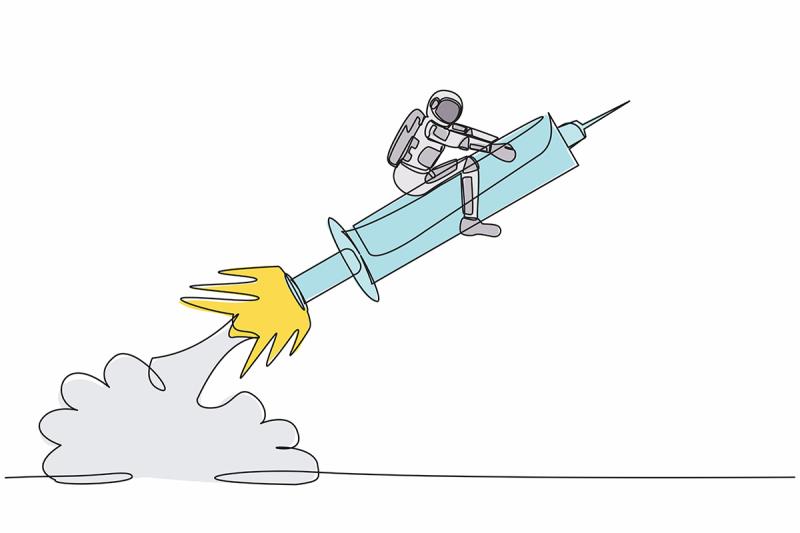Rocatinlimab delivers in ROCKET-SHUTTLE trial





Findings from the phase III ROCKET-SHUTTLE trial support the treatment potential of rocatinlimab for atopic dermatitis (AD).
“Rocatinlimab demonstrated statistical significance for both coprimary endpoints vs placebo at week 24 in a diverse treatment-experienced population with moderate-to-severe AD on low-to-medium potency TCS/TCI*,” said Professor Eric Simpson from Oregon Health & Science University, Portland, Oregon, US, at EADV 2025.
Compared with the placebo arm, the rocatinlimab arms had twice as many participants achieving EASI 75** (52.3 percent [300 mg] and 54.1 percent [150 mg] vs 23.5 percent [placebo]) and vIGA-AD™ 0/1*** (26.1 percent and 25.8 percent vs 12.2 percent) at week 24 (p<0.001 for all comparisons). [EADV 2025, abstract LBA 78]
Looking at the kinetics of EASI 75, there was not much difference between the rocatinlimab arms, but there was a progressive march over 24 weeks; there was a nice separation between the rocatinlimab and placebo arms starting week 4, Simpson said. For vIGA-AD™ 0/1, the active and placebo curves only separated after week 12. Nonetheless, there were no real plateaus.
“The progressive efficacy may reflect its proposed mechanism of action as a T-cell rebalancing therapy … We are very curious to see how these rebalancing treatments are going to do over the long haul and if these numbers are going to continue to increase over time,” Simpson said.
Other outcomes
The depth of skin response increased over time with rocatinlimab vs placebo, as evidenced by the progressive increase in the proportion of participants achieving EASI 75–89** and EASI 90–100** through week 24. Despite using topicals, placebo recipients plateaued early, noted Simpson.
More patients on rocatinlimab vs placebo exhibited ≥4-point reductions in WP-NRS# (44.3 percent [300 mg] and 40.7 percent [150 mg] vs 23.7 percent) and SP-NRS# (47.2 percent and 45.7 percent vs 27.1 percent) at week 24.
The active drug was generally well tolerated, with low incidences of serious adverse events (AEs; 3.1 percent [300 mg] and 4.4 percent [150 mg]) and treatment-emergent AEs leading to its discontinuation (1.4 percent and 3.1 percent).
“Injection-related pyrexia, headache, and chills were mild to moderate in severity, predominantly reported after the first dose, and resolved within 48 hours,” Simpson said.
New therapies warranted
“Novel therapies for AD are needed, as not all patients respond to currently available treatments. AEs can happen, and patients can lose response,” Simpson said.
A total of 746 AD patients (mean age 38.2 years, 59.4 percent men, 31.5 percent Asian) who had insufficient response to medium-to-high potency TCS/TCI were randomized 5:4:4 to rocatinlimab 300 or 150 mg, or placebo Q4W for 24 weeks on top of TCS/TCI.
At the investigator’s discretion, medium-potency TCS was applied QD; upon lesion control, this was downtitrated to low-dose TCS for 7 days, then discontinued. Topicals may be restarted if lesions reappeared at some point during the trial. For patients who worsened or had unacceptable AD symptoms, rescue with standard-of-care therapy (ie, high-potency topicals and systemics) was allowed from day 1.
Sixty percent of participants had a moderate vIGA-AD™ score, 71.7 percent had severe/very severe EASI total score, ~60 percent had prior systemic therapy, and 25.3 percent had prior advanced systemic therapy.
Fewer rocatinlimab vs placebo recipients resorted to rescue therapy through week 24 (11.5 percent [300 mg] and 12.2 percent [150 mg] vs 20.9 percent).
Along with the results of ROCKET-HORIZON and ROCKET-IGNITE, the current findings support the efficacy and safety of rocatinlimab administered with TCS/TCI. The ability of rocatinlimab to deliver deeper responses beyond week 24 and the possibility of time off drug will be ascertained in the ongoing ROCKET-ASCEND trial, Simpson said.